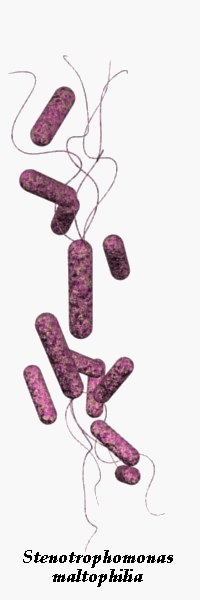

Stenotrophomonas maltophilia is a straight, Gram-negative rod. These bacteria are motile due to the presence of 4 polar flagella.
They are catalase positive, and most are either negative or weakly oxidase positive. They grow on MacConkey agar and appear to be nonfermenters (lactose negative colonies on Endo agar (A, C), CLED (D) and MacConkey agar (H).
They form small colonies after 24 hours at 37 °C on solid cultivation media (A, C, D, H) and medium, smooth, convex colonies about 3 mm in diameter after 48 hours (B, E, G).
S. maltophilia usually produce yellowish soluble pigment. B, E: Mueller-Hinton agar, 48 hours, 37 °C.
General information
Stenotrophomonas maltophilia has previously been referred to as Pseudomonas maltophilia and subsequently Xanthomonas maltophilia.
S. maltophilia is an opportunistic pathogen which is commonly found in and around water, both in the wider environment and in hospitals. It can survive a very minimal nutrient concentration. It can also form biofilms on plastic surfaces, so can therefore be found on medical devices e.g. nebulisers and cannulas. It has optimal growth at 35 °C, no growth at 4 °C or 41 °C but can survive refrigeration.
It most commonly causes respiratory infections in humans. Human infection is relatively rare but is becoming more prevalent especially in hospital settings. S. maltophilia infection is much more common in cystic fibrosis patients as well as obstructive lung cancer patients. S. maltophilia is also able to cause other infections including bacteraemia, meningitis, cellulitis, and eye infections. It also causes infections in the general community outside the hospital setting, but this is even more rare.
S. maltophilia may be associated with polymicrobial infections or grow slowly in the host, resulting in some difficulty in isolating this bacterium. It is occasionally misidentified as Burkholderia cepacia (previously known as Pseudomonas cepacia), which is also a common Cystic Fibrosis-associated pathogen.
Text: Eva Van Dijk
Stenotrophomonas maltophilia basic characteristics
- GRAM-NEGATIVE RODS
- MOTILE (polar multitrichous flagella)
- NON-SPORE-FORMING
- CATALASE: POSITIVE
- OXIDASE: NEGATIVE (about 80 % isolates; many strains are weakly oxidase positive)
- AEROBIC
Identification of Stenotrophomonas maltophilia
| Nitrate reduction | V (-) | Acid from: | |
| Pigment production | Brown-tan, soluble | Glucose | V (+) |
| Indole | - | Lactose | V (+) |
| Arginine dihydrolase | - | Sucrose | V (+) |
| Lysine decarboxylase | + | Xylose | V (-) |
| Ornithine decarboxylase | - | Mannitol | - |
| Urea hydrolysis | - | Maltose | + |
| Citrate hydrolysis | V (-) | ||
| Gelatin hydrolysis | V (+) | Hemolysis | - |
| Esculin hydrolysis | V (-) |
Antibiotic treatment
S. maltophilia is difficult to treat, having already shown resistance to TMP-SMX, β-lactam antibiotics, macrolides, fluoroquinolones, aminoglycosides, chloramphenicol, tetracyclines, and polymyxins. Its metabolic pathways may even enable it to use some antibiotics as a food source.
NOTE: S. maltophilia isolates can exhibit differences in antimicrobial susceptibility depending on the temperature they are incubated at (higher resistance is typically observed at temperatures that are closer to 37 ºC). From https://www.ncbi.nlm.nih.gov.
- Trimethoprim-Sulfamethoxazole (Co-trimoxazole) (TMP-SMX)
ALTERNATIVE:
- Ceftazidime
- Ticarcillin/clavulanate
- Ciprofloxacin
- Moxifloxacin
- Levofloxacin
Stenotrophomonas maltophilia colonies on agar cultivation media
Stenotrophomonas maltophilia on blood agar







Stenotrophomonas maltophilia on MacConkey, CLED and Mueller-Hinton agar





Stenotrophomonas maltophilia identification





Stenotrophomonas maltophilia antibiotic susceptibility



Stenotrophomonas maltophilia Gram

Useful Links
WIKIPEDIAArticles
- Stenotrophomonas maltophilia: an Emerging Global Opportunistic Pathogen
- Update on infections caused by Stenotrophomonas maltophilia with particular attention to resistance mechanisms and therapeutic options
